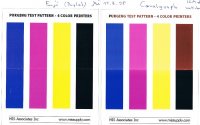martin0reg
Printer Master
So that's the scientific backgound of (over)heated bubble jet nozzles.
Regarding the practice I already have got your answer here, didn't I..?
http://www.druckerchannel.de/forum.php?seite=beitrag&ID=276290&s=1#comments
I'm still asking myself what is worse and causes more damage to a canon printheads:
3rd party "compatible" ink which does not have the correct chemical properties
or the fuji drylab ink which is probably made originally for piezo printheads.
Okay, "probieren geht über studieren", but trying the DL ink can cost me a canon PH..
Regarding the practice I already have got your answer here, didn't I..?
http://www.druckerchannel.de/forum.php?seite=beitrag&ID=276290&s=1#comments
I'm still asking myself what is worse and causes more damage to a canon printheads:
3rd party "compatible" ink which does not have the correct chemical properties
or the fuji drylab ink which is probably made originally for piezo printheads.
Okay, "probieren geht über studieren", but trying the DL ink can cost me a canon PH..

